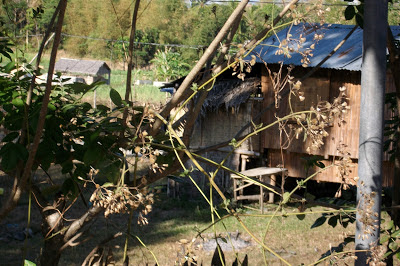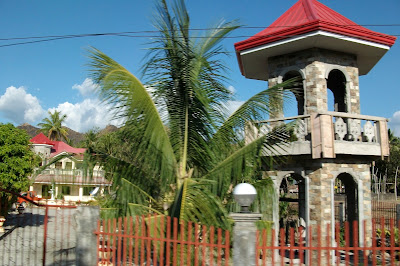Less than five minutes from our neighborhood, we cross the first of several
long bridges encountered between Tibiao and San Jose. There are more
than 30 various bridges along this stretch of road, and 3 or 4 of them cross
floodplains requiring them to be several-hundred-yards (meters) long.
These larger rivers nearly always have sand- and- gravel excavation
in progress. Everything substantial in this area is built of concrete,
and here is the raw material in abundance.

Typical stretch of road, main highway 2-lane 20-feet wide. Fringes of
trees, lots of agriculture (mostly rice, but corn, sugarcane and peanuts
are seen, too). Unusual not to have other traffic in the scene. This trip,
I was in the front seat on the right. Sometimes the ride is placid, but
it can quickly become more interesting - kind of like a road-race
video game, at times.

in Patnongan for quite a while. The vehicles I'm in rarely stop where I'd
like them to for photo purposes; but since I was in the front seat and knew
we would be "setting up" for the wide right-hand corner before the Academy,
I stuck my arm 'way out the right side, took a guess at aiming, and pushed
the button. Yahooo - -The mirror you see is the right-front-corner of the bus.
St. A's has been around for quite a while; guess it's time for me to research it.
(LATER: online search for info about St. A's got me nothing).

Sign often seen but not observed. Philippine drivers in general are
much more attentive and courteous than most places I have been.
They have to be so!! The "unwritten rules" here are different - any
speed that conditions will allow is legal. Drivers starting out MUST
look first, because in any place another vehicle may be approaching
at high speed. Drivers already on the road will begin sounding the
horn as a precaution if they see any possible chance of a mishap.
A horn is not an insult here, it is a necessary protection.
I think we stopped just before this bridge, to pick-up or drop passengers.
Otherwise there's little chance that the Coca-Cola truck would ever be
passing us. In our area there are a lot of familiar brand-names on trucks
and in stores. There will be a truck blog- post sometime soon - having
been a trucker for so long, I'm surprised I haven't already done one.

Whenever this delivery tricycle goes around a corner, you'd have to
say "The Tide has turned . . ."

Belison Public Market always appears busy and bustling, with many
tricycles and other vehicles out in front. Its well-worn appearance - -

contrasts with the sprawling openness of school and church campuses
directly across the highway.

Arriving in SanJo (as I often abbreviate it) I switch to snapping my
photos from the back seat of a tricycle taxi, craning around to get
a shot on the left past the driver's head. Except for tricycles, street
scenes here remind me a lot of trips we took to Tijuana, Calexico,
and Juarez, Mexico years ago.

This business has a great selection of tools, tiles, and electric and
plumbing fixtures. Our coach-type porch lights came from here.

Here's one of my favorite photos. Philippine Government seems to
NOT have too much regulation, usually. This may be an exception,
since coconuts grow wild all over the place here. What needs any
"Authority?" I've had a lot of fun imagining the Coconut Agents
riding around in dark tinted-glass SUVs, wearing pinstripe suits and
sunglasses but with flip-flops on their feet, calling in the SWAT team
for enforcement and negotiations . . .(smile)
(Please Note: the foregoing is not to be taken as a criticism of any
person or agency. It is only my attempt to be humorous about my
personal aversion to any perceived over-involvement by any
government in my activities, or anyone else's activities.)
than 30 various bridges along this stretch of road, and 3 or 4 of them cross
floodplains requiring them to be several-hundred-yards (meters) long.
These larger rivers nearly always have sand- and- gravel excavation
in progress. Everything substantial in this area is built of concrete,
and here is the raw material in abundance.

Typical stretch of road, main highway 2-lane 20-feet wide. Fringes of
trees, lots of agriculture (mostly rice, but corn, sugarcane and peanuts
are seen, too). Unusual not to have other traffic in the scene. This trip,
I was in the front seat on the right. Sometimes the ride is placid, but
it can quickly become more interesting - kind of like a road-race
video game, at times.
Overarching of trees is pretty frequent. This area reminds me of some
secondary routes in California.
Getting into an area of houses inside walled compounds, a rambling
bougainvillea vine accents the roadside. You never quite know what
will be around such a curve as this one - - -
but suddenly you've passed from open countryside to the middle of a
bustling small town. This is Bugyasong. The Suzuki pickup truck
approaching ("flat-nose, bug-eyed") is about 2/3 of the size of a Ford
Ranger or other compact pickup. These are very common here.
The town-hall expansion project, in progress. Every single stacked bag
of sand and gravel will be hand-carried into the site and mixed into cement
for the project. I did see a couple portable cement mixers here. The large
machines on display I thought were some type of huge winch. Turns out
they are fake, commemorative sculptures of sugarcane presses.
At the edge of town, just before a medium-river bridge, the local
funeral parlor has a selection of caskets on display at the roadside.
A couple minutes later you may find yourself riding alongside the ocean
shore. We are on the west coast of Panay Island; this part of the Pacific
Ocean is named on maps as "Sulu Sea" and seems to be the ocean area
bounded by our island and the closest islands west and north of us.
Approaching a road-work project; "your tax money at work for you"
sign very similar to ones seen in the U.S.

We overtook this load of bamboo and passengers at about the same
rate an F-16 would pass Orville Wright. At first I thought the vehicle
would be a tricycle; turns out it's a trailer pulled by a 2-wheel "walk-
behind" farm tractor. These are common here; they look something like
a roto-tiller on steroids, and are often seen in rice-fields with paddle-
wheels instead of tires, because of extra-muddy conditions.
I mentioned in my posting about Jeepneys that they are often loaded with
top-freight and will have passengers hanging all over outside. This one
we're just about to zip past is only a fair example, not nearly as piled-
up as some I've seen. I'll share a gallery of loaded vehicles another time.
A little tin-roof bamboo house glimpsed near the road sits near a few
acres of vegetable crop-land and rice fields. Very typical scene, amid
other much more prominent establishments.
This tower is near the road, is inside several acres of fenced and
landscaped yard-space . . .
. . . with this house, illustrating the contrasts often seen within a few
seconds while travelling here.
I had been wanting to get a decent photo of St. Augustine's Academyin Patnongan for quite a while. The vehicles I'm in rarely stop where I'd
like them to for photo purposes; but since I was in the front seat and knew
we would be "setting up" for the wide right-hand corner before the Academy,
I stuck my arm 'way out the right side, took a guess at aiming, and pushed
the button. Yahooo - -The mirror you see is the right-front-corner of the bus.
St. A's has been around for quite a while; guess it's time for me to research it.
(LATER: online search for info about St. A's got me nothing).

Sign often seen but not observed. Philippine drivers in general are
much more attentive and courteous than most places I have been.
They have to be so!! The "unwritten rules" here are different - any
speed that conditions will allow is legal. Drivers starting out MUST
look first, because in any place another vehicle may be approaching
at high speed. Drivers already on the road will begin sounding the
horn as a precaution if they see any possible chance of a mishap.
A horn is not an insult here, it is a necessary protection.
I think we stopped just before this bridge, to pick-up or drop passengers.
Otherwise there's little chance that the Coca-Cola truck would ever be
passing us. In our area there are a lot of familiar brand-names on trucks
and in stores. There will be a truck blog- post sometime soon - having
been a trucker for so long, I'm surprised I haven't already done one.

Whenever this delivery tricycle goes around a corner, you'd have to
say "The Tide has turned . . ."

Belison Public Market always appears busy and bustling, with many
tricycles and other vehicles out in front. Its well-worn appearance - -

contrasts with the sprawling openness of school and church campuses
directly across the highway.

Arriving in SanJo (as I often abbreviate it) I switch to snapping my
photos from the back seat of a tricycle taxi, craning around to get
a shot on the left past the driver's head. Except for tricycles, street
scenes here remind me a lot of trips we took to Tijuana, Calexico,
and Juarez, Mexico years ago.

This business has a great selection of tools, tiles, and electric and
plumbing fixtures. Our coach-type porch lights came from here.

Here's one of my favorite photos. Philippine Government seems to
NOT have too much regulation, usually. This may be an exception,
since coconuts grow wild all over the place here. What needs any
"Authority?" I've had a lot of fun imagining the Coconut Agents
riding around in dark tinted-glass SUVs, wearing pinstripe suits and
sunglasses but with flip-flops on their feet, calling in the SWAT team
for enforcement and negotiations . . .(smile)
(Please Note: the foregoing is not to be taken as a criticism of any
person or agency. It is only my attempt to be humorous about my
personal aversion to any perceived over-involvement by any
government in my activities, or anyone else's activities.)
Well, that's a lot of photos but as usual I've had to pick through a lot which I would like to have included. I think the count is more than 20 this time so I better quit. There are all kinds of things I haven't had a chance to post on this blog yet, so I'm not quite sure which topic will grab my interest for next time. The finishing details on our house are keeping me really busy at this time but I will try to get another posting up reasonably soon.
Have a blessed and wonderful day, wherever you are. Life often consists more in how we look at things (attitude) than is what those things actually are.
Tim and Bernadette Larson, Philippines


























